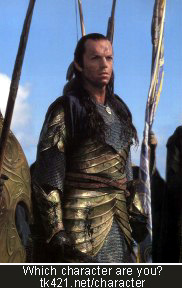July 3, 1863--Pickett's Charge
 On this day in 1863, in Gettysburg, Pennsylvania, the invading wave of the Confederate Army of Virginia crested and broke in front of the Union lines. The photo above, taken at a modern re-enactment, shows how Pickett's Charge looked from the Union lines atop Cemetery Ridge.
On this day in 1863, in Gettysburg, Pennsylvania, the invading wave of the Confederate Army of Virginia crested and broke in front of the Union lines. The photo above, taken at a modern re-enactment, shows how Pickett's Charge looked from the Union lines atop Cemetery Ridge.On the same day, some 1045 miles to the southwest, the Confederate forces at Vicksburg, Mississippi surrendered to the Union army led by General Ulysses S. Grant. Upon hearing the news, President Lincoln proclaimed, "The Father of Waters again goes unvexed to the sea."
On this single day, one day short of the 87th anniversary of the Declaration of Independence (Lincoln's famed "Four score and seven years ago"), the fate of the United States was determined. Although nearly two years of bloody fighting lay ahead, from that day on the Confederacy was fighting a holding action.
In the view of many, including General James Longstreet, the commander of General Pickett at Gettysburg, the Confederacy lost the Civil War that day, due to two ill-considered decisions: First, Army of Virginia Commander General Robert E. Lee and Confederate President Jefferson Davis, following the Confederate victory at Chancellorsville, elected to have the Army of Virginia invade the North, in the hope of luring out and destroying the Army of the Potomac, and thereby persuading the Lincoln Administration to seek a negotiated peace. The alternative would have been to use the Army of Virginia to try to relieve the siege at Vicksburg. Longstreet favored the latter course of action, because he recognized that the fall of Vicksburg would cut the Confederacy in two.
The second fateful and misguided decision was Lee's order, against Longstreet's protests, to risk an all-out infantry assault, across nearly a mile of open ground offering the Union forces a devastating field of fire, against the center of the well-entrenched Union line atop Cemetery Ridge. It was Fredericksburg in reverse.
Perhaps it is only a coincidence that the Union victories at Gettysburg and Vicksburg in 1863, which preserved the Union, occurred during the same days that the Continental Congress passed the resolution for American independence and signed the Declaration of Independence in Philadelphia in 1776. However, I believe in Divine Providence, not coincidences. While one cannot gainsay the gallantry and bravery of the Confederate armies, my strongly held opinion is that rarely if ever were such noble virtues devoted to a less-deserving cause.
The struggle to preserve the Union truly was, to paraphrase Lincoln's Gettysburg Address, a test of whether a nation conceived in liberty, and dedicated to the proposition that all men are created equal, can long endure. As we approach the Fourth of July, 2006, that question perhaps still remains unanswered. Let us therefore remember those who fell on both sides at Gettysburg and Vicksburg on this day, those who have fought in all of our wars to preserve our liberty, and those who serve in the United States Armed Forces today. As President Lincoln concluded on November 19, 1863, at the dedication of the Gettysburg National Cemetery:
It is for us the living, rather, to be dedicated here to the unfinished work which they who fought here have thus far so nobly advanced. It is rather for us to be here dedicated to the great task remaining before us -- that from these honored dead we take increased devotion to that cause for which they gave the last full measure of devotion -- that we here highly resolve that these dead shall not have died in vain -- that this nation, under God, shall have a new birth of freedom -- and that government of the people, by the people, for the people, shall not perish from the earth.





2 Comments:
Just curious - is it Seminary Ridge or Cemetery Ridge?
(discrepency between your last two blogs?)
Also, this site refers to the Battle of the Bulge as the most costly battle of WWII. Iwo Jima cost me an uncle and was apparently hell on earth.
http://www.zenithpress.com/Store/ProductDetails_9972.ncm
Posted by DL
DL: It is both actually. On July 3, 1863, the Union Army was entrenched in a fishhook-shaped formation on top of Cemetery Ridge, from Culp's Hill on the northeast, which was the point of the hook, to Little Round Top and Big Round Top in the south, which was the end of the shaft of the hook. The center of the Confederate lines was Seminary Ridge. (Hedgehog is describing the view from the Confederate lines in his post.) Two days earlier, at dawn on the first day of fighting at Gettysburg, July 1, Heth's division of the Army of Virginia came down from the mountains west of Gettysburg and attacked Union positions on Seminary Ridge, initially held only by Union General Buford's cavalry, who were reinforced by the arrival of the Union First and 11th Corps. Although initiallly rebuffed, when a Confederate army corps under the command of General Ewell arrived from the north, flanking the Union positions, the renewed Confederate attack, now by two corps, drove the Union troops off Seminary Ridge and out of the town of Gettysburg. At nightfall on July 1, the beleagered Union troops managed to regroup and dig in on top of Cemetery Ridge, where by the next day they had been reinforced by nearly the entire Army of the Potomac, coming up from the southeast. The next two days of the battle consisted of repeated unsuccessful Confederate assaults against the Union lines. Thank you for your loyal readership, DL!
Posted by The Kosher Hedgehog
Post a Comment
<< Home